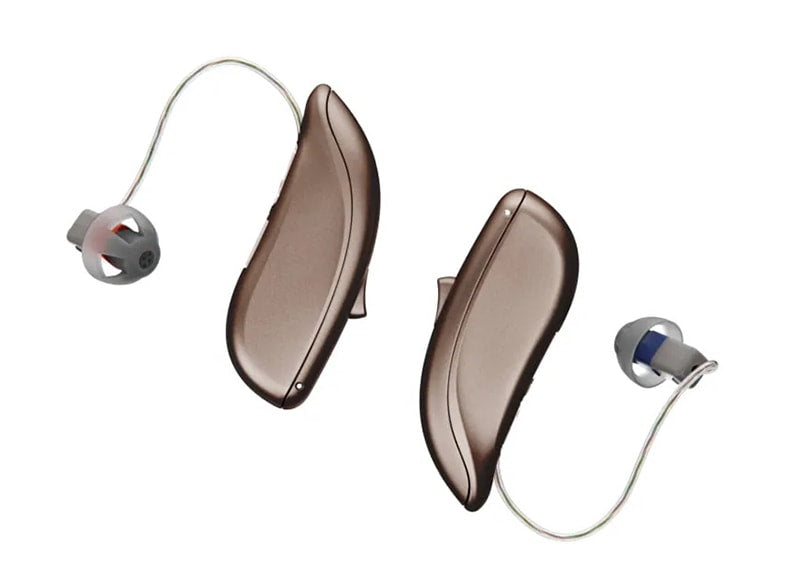As a male of 67 years (as of this writing), I’ve recognized for some time that my ears are not the golden performers they once were. I’ve recently confirmed through formal testing that I’m suffering mild hearing loss from the upper-mid frequencies on up, no doubt helped along by rock concert attendance in my 20s and 30s, before I came to understand the permanent damage they cause, and knew to invest in quality earplugs.
I’ve known my hearing was diminishing for a couple of years – I’ve had progressively more difficulty understanding conversations in loud environments, or in the monthly public meetings my job requires me to attend. Even television broadcasts aren’t as clear as they used to be. For some time, I’ve claimed it was a change in the way broadcasts are produced – that engineers these days deliberately push loud backgrounds and music over simultaneous speech, making it hard to understand. They bump up crowd noise during broadcast sports to make it sound more exciting, despite the fact it makes the announcers impossible to understand. I continued to think, it can’t be me; it must be them. It can’t be hearing loss, because I don’t need more volume, I just need more clarity. Turns out that was wrong, and hearing aids are now on their way.
Why am I writing about this? First, to discuss an apparent dichotomy between our ears’ performance limits and the qualities of audio reproduction that make certain recordings sound lifelike; and second, as a means to fend off as much as possible the trepidation I feel as I make this latest transition to senior-hood, with all the ramifications that hearing aids might have for my ego and my status as an “audiophile.” Kind of like whistling past my audio grave, if you will.

Craig Burgess.
When I was cutting my hi-fi teeth in the 1970s, one of the prime performance characteristics touted by manufacturers and reviewers alike was extended frequency response. Even if a pair of young, healthy ears topped out at 16 – 18 kHz (or lower – even a pure 12 kHz tone sounded impossibly high), the consensus was that we really needed reproduction that pushed 20 kHz or beyond, in order to provide the micro-cues that our brains needed to recognize things like “air,” texture, accurate timbre, or the leading edge of transients of all kinds. So, we pursued that performance, and kidded ourselves that we really heard, or at least somehow perceived, those sounds, even though the frequency sweeps and tones of our test records made it clear we couldn’t hear anything close to them. We just assumed that those test records were labeled wrong, or the system wasn’t performing correctly, or that regardless, we possessed some kind of bat- or dog-like sense we couldn’t explain but that nevertheless responded to these signals we clearly weren’t hearing, all in order to explain the quality we found in recordings that our systems reproduced well. And by “well,” I mean with a palpable sense of realism, not simply spectacular hi-fi bombast. I mean sounds that can fool you into thinking they’re coming from a person or instrument, loud or soft, that’s there, in your presence.
So what is it in the recording/mixing/mastering process, the manufacturing of the physical medium, or the reproduction chain (or a combination of the three) that results in these “realistic” recordings? We all possess records and CDs that have great knock-your-socks-off sound, but even among those, I would wager we each have a smaller subset of recordings that go beyond a purely impressive range of frequency and dynamics, beyond the punch of a bass drum and the sparkle of a cymbal, and that provide a genuine you-are-there quality. I suspect the path to that sound is not fully understood, at least by many, or all recordings would possess it.
I’m coming to realize, though, that extended high-frequency response is not the answer, at least to the exclusion of other factors. Every hi-fi enthusiast that I know personally has confirmed to me that they’ve experienced the phenomenon of hearing a recording for the first time in an environment less than conducive to critical reproduction or critical listening, and still noticing the germ of quality in what they heard. It could a noisy car interior, or playback through a mobile phone or a small, tinny Bluetooth speaker. Regardless, something catches our ear/brain and makes us think, “this one is worth listening to at home, on the nice system. I bet it sounds great.” I’m sure that has happened to most of you. So, what are those auditory cues that produce that reaction? I suspect they’re unrelated to extended high-frequency response, since those systems and environments are surely missing (or masking) that information, just as they’re assuredly limiting dynamic range and a host of other qualities we think of as critical to high-fidelity music reproduction. But something is there, something perceptible, that hints at genuinely realistic sound quality if given the right playback circumstances.
Which brings me back to where I started. Since my hearing loss is limited to a specific band of higher frequencies, this gives me some hope that the world of high-quality, realistic music reproduction isn’t being closed off to me completely by the fact that I’ll be using hearing aids soon. It suggests to me that the audio qualities I treasure in listening may lie outside that limited set of performance characteristics. Otherwise, I’d find my system provides progressively worse performance as I get older, but in fact it doesn’t. As it stands now, it’s producing the finest sound I’ve ever heard from it during its evolution of the past 45 or so years. There are questions remaining, to be sure – will I be able to enjoy the system just as well once I’ve started using the devices and are accustomed to them, or will I discover I need to remove them when listening to music? Will my brain treat them like eyeglasses, where initial optical distortions are eventually compensated for by the brain? All those questions will be answered in time. Whether my audiophile cred or my ego will take irredeemable hits are different matters. We’ll see about those.
I’d love to hear others’ thoughts about what makes for a realistic recording, and if you wear them, stories about audiophile life with hearing aids.
About the Author
Craig Burgess is a registered architect who is currently appointed Building Commissioner of the State of Indiana. His love of music dates back to grade school band, in which he played cornet; he later moved on to bluegrass banjo, acoustic guitar and piano. His love of hi-fi began in high school, and it was kicked into high gear while in college, when he discovered The Absolute Sound and the high end.
Header image: hearing aids, from the Lively website.



